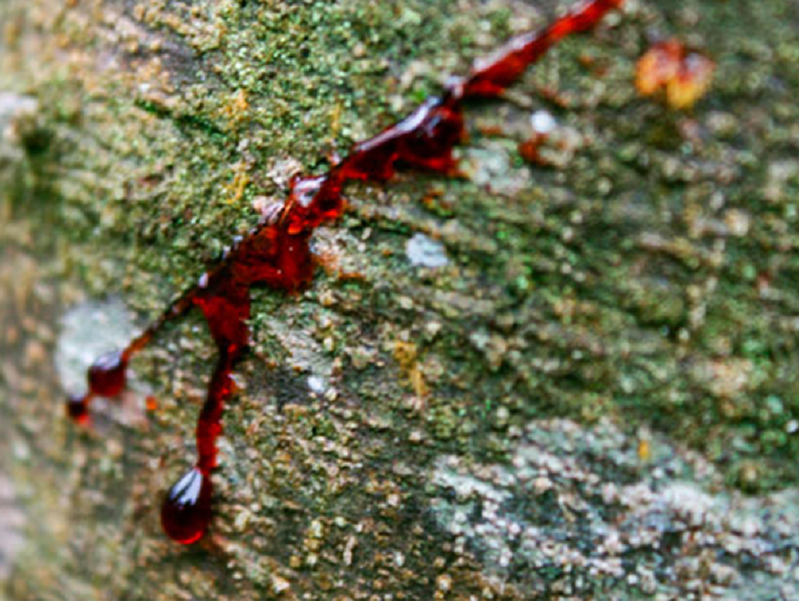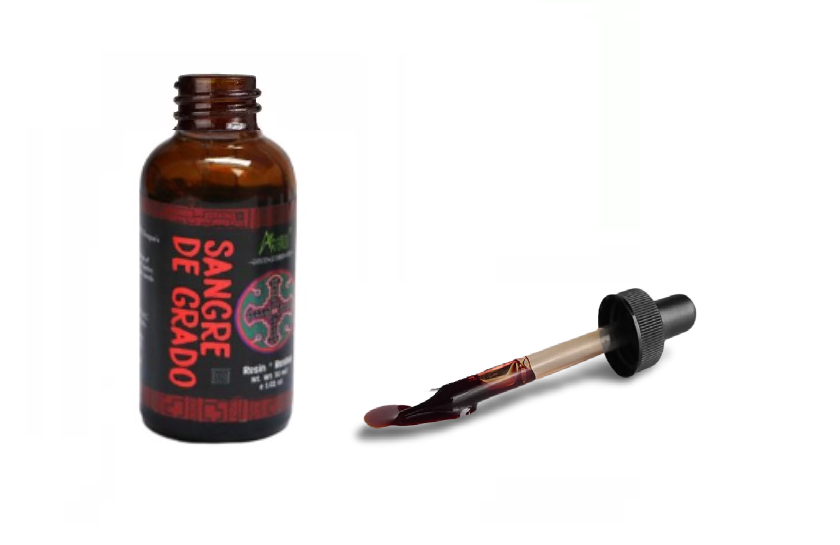Dragon’s Blood Liquid Extract:
Benefits and Usage
Do you want to improve your wound healing process, prevent skin infections or get rid of gastritis? Dragon’s Blood is the best natural solution!
Dragon’s Blood is a latex or sap obtained from trees of the genus Croton. These Amazonian trees are common on the hillsides of Peru, Colombia, Bolivia and Ecuador. Historically, in the traditional medicine of Peru, this sap has been used on wounds to stop bleeding, accelerate the healing process by avoiding noticeable scars and protect injuries from infection, serving as a barrier or “second skin”.

Within the Croton genus, the Croton lechleri tree is the most studied and has proven properties as a powerful anti-inflammatory, healing, antiviral, antibacterial, antiseptic and analgesic. This tree reaches between 10 and 20 meters high. The way to obtain this wonderful substance is really surprising. The trunk of this plant produces a kind of reddish sap (latex) that is extracted through an incision in the form of “v” in the bark that expels as if it were “bleeding”.

The first records of its use date back to the 17th century, when the Jesuit Bernabé Cobo wrote about the widespread use of Dragon’s Blood among the indigenous people of Mexico, Peru and Ecuador. Today, its properties to stop bleeding, heal wounds and protect against infection are discussed in books such as The Healing Power of Rainforest Herbs, by American naturopath Leslie Taylor.
Is it medically endorsed?
References on the use of the properties did not remain only in history. Hundreds of studies have been conducted to support its effectiveness. Since the 1980s, scientists have discovered that the healing power of Dragon’s Blood mainly related to the alkaloid called taspine.
Subsequent research in several countries has confirmed these early observations. Research published in 2004 in The Journal of Alternative and Complementary Medicine notes that the results largely support most ethnomedical uses of Dragon’s Blood.
Another study published in 2016 in The Journal of Traditional and Complementary Medicine and on the Science Direct website concludes that thanks to taspine and other compounds, Dragon’s Blood is a good and potent option for wound healing because it is natural, accessible, safe and affordable. In addition to healing, the aforementioned book also attributes anti-tumor and antiviral powers to taspine.
Oligomeric proanthocyanidins, or crofelemer, is another chemical compound contained in Dragon’s Blood. In January 2013, the U.S. Food and Drug Administration (FDA) approved crofelemer, under the trade name Mytesi, for the treatment of non-infectious diarrhea in HIV-positive patients.
How does Dragon's Blood help us?
• In healing and wound care
Recent studies confirm the biochemical role of Dragon’s Blood as a beneficial healing agent in reducing the average healing time of spider bites, abrasions and blisters. In animals it has been proved that this liquid is able to contract the edges of a wound, promotes the increase of fibrin and collagen. In addition, it generates an important increase in fibroblast migration that favors cell regeneration.
On the other hand, the polyphenolic compounds of the sap create a protective layer on the wound surface, preventing the entry of pathogenic microbes.
• Gastritis
Internally it can help the healing of gastric ulcers and has a bactericidal effect on helicobacter pylori. It is also an excellent protector of gastric cells.
• Antimicrobial activity
Its power is not limited to fighting helicobacter pylori. Some compounds of Dragon’s Blood, such as trimethoxyphenol, trimethoxybenzene, crolequinic acid and korberins A and B showed antibacterial properties individually. In addition, its catechins and epigallocatechin are antifungal.
Dragon’s Blood has also shown antiviral activity against influenza, parainfluenza, herpes simplex viruses I and II, and hepatitis A and B. The most notable compound involved in antiviral activity is SP-303, also known as crofelemer, which has been extensively studied in vitro for its antiviral activity.
• Antimicrobial activity
Its power is not limited to fighting helicobacter pylori. Some compounds of Dragon’s Blood, such as trimethoxyphenol, trimethoxybenzene, crolequinic acid and korberins A and B showed antibacterial properties individually. In addition, its catechins and epigallocatechin are antifungal.
Dragon’s Blood has also shown antiviral activity against influenza, parainfluenza, herpes simplex viruses I and II, and hepatitis A and B. The most notable compound involved in antiviral activity is SP-303, also known as crofelemer, which has been extensively studied in vitro for its antiviral activity.
• Intestinal problems
Dragon’s Blood is taken orally for gastrointestinal disorders and irregularities including intestinal infections and inflammation. Crofelemer, previously mentioned, has anti-diarrheal activity. Several clinical studies have confirmed significant improvement in cases of acute E. coli and V. cholera diarrhea from the administration of crofelemer. It will also help with symptoms of gastroenteritis, ulcerative colitis and irritable bowel syndrome.
• Beauty
Dragon’s Blood soaps are used to mitigate acne or other lesions on the face.
• In oral health
Dragon’s Blood is regularly used to control canker sores, cracks in the oral mucosa, parodontopathies and is an excellent oral antiseptic.
Currently, the scientific community is investigating whether Dragon’s Blood would have a positive action against leukemia, but there is no scientific support yet.
What is the correct way to use Dragon's Blood?

For its ingestion, it is advisable to dilute about 3 drops in infusions such as plantain or marshmallow. Remember to respect the dosages recommended by the manufacturer.
For external use, you can apply a few drops directly on the skin 2 to 3 times a day until absorbed. Just be careful not to stain your clothes.
Is it toxic?
Under experimental conditions, oral administration of Dragon’s Blood in therapeutic doses has not produced hepatic or renal biochemical alterations in experimental animals. However, due to its alkaloid content, it is contraindicated in pregnancy, lactation and in children under 12 years of age. In addition, it could cause constipation if we exceed the recommended use.
The use of this wonderful substance has spread rapidly in countries such as Russia, Australia, Canada, China, United States, among others. Now that you know the great benefits of Dragon’s Blood, you should know that there are many presentations to choose from. You can find it in extract (drops), soaps, creams and even in soft capsules. Do not fail to take advantage of this magnificent natural solution that gives us the Earth!
Reference link:
https://www.indecopi.gob.pe/documents/20791/3180041/sangre+de+grado.pdf/17a80543-27c3-c45d-0d47-3fc18398e9e0
http://insteractua.ins.gob.pe/2021/11/sangre-de-grado-infografia.html
https://www.cuerpomente.com/guia-plantas/sangre-de-dragohttps://sangrededrago.info/
https://www.bbc.com/mundo/noticias-50920495https://en.wikipedia.org/wiki/Croton_lechleri



